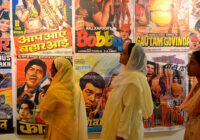In India, the status quo of gender is promoted in popular culture.
Reading through a Times of India article from 2013, “International Women’s Day: Bollywood and its bold women characters,” I was excited to see the names of movies I had watched, like Mother India (1957), Aandhi (Storm 1974) and English Vinglish (2012). I could relate to what it meant by “bold” characters. Compared to other mainstream movies with male protagonists, these films did have strong roles for women. Bold, because they were performing outside of defined roles.
But, as usual, most Bollywood films have male protagonists. Will a few movies with “bold” female characters make any difference? What about the women in other mainstream Bollywood movies?
Looking at two films by Karan Johar—Kabhi Khushi Kabhi Gham (A While of Happiness and A While of Sorrow, 2001) and Kabhi Alvida Na Kehna (Never Bid Goodbye, 2006)—might help understand how women are characterized in mainstream Bollywood movies. Johar was considered very talented among the young generation of directors during the 2000s, which was the marking of a new era. Most importantly, he has declared himself as a family filmmaker.
Both of these films were huge box office hits, so they provide a great insight into sphere-defined roles of women.
Gendered Roles
In the movie Kabhi Khushi Kabhi Gham, the division of gender roles is portrayed right from the casting where the flashback shows an infant growing up. As he is becoming of age, the son does not appear with his father once. It is the mother who plays with him, feeds him and takes care of him while he is ill.
Similarly, there is a scene of daadi (paternal grandmother) and naani (maternal grandmother) talking, where the daadi expresses her regrets regarding how she could not take care of the home properly, and as a consequence could not bring the separated family together. She fears that when she dies, she will have to face God and will not have any proper answer for him.
The scene is very short but their conversation reflects the social definition of gendered duties, where women are portrayed as caretakers of the household, responsible for everything that happens inside. There are many such scenes and dialogues in this film that convey the best-suited roles for men and women. Even the words and phrases used in the title song “Kabhi Khushi Kabhi Gham” (sung by Jaya Bachchan in the movie) shows the husband to be superior to his wife—she is merely her husband’s shadow:
“Meri saanson main tu hai samaya [You are the one captured in my breath]
mera jeewan toh hai tera saaya [My life is a shadow of you]
teri pooja karun main toh hardam [Let me worship you always]
yeh hain tere karam kabhi khushi kabhi gham [It is your kindness, a while of happiness and a while of sorrow]”
While the song is sung during Diwali (festival of lights), the lyrics initially appear to be praising God, however, when the husband, Amitabh Bachchan, appears in the song she repeats the same phrases for him. She appreciates and shows her gratefulness to the husband for being kind and taking care of them.
 Similarly, there are other dialogues that reveal how patriarchal ideologies of male supremacy are transferred from one generation to the next. For example, toward the end of the movie, Jaya says: “My mother used to tell me all the time that husbands are incarnation of Gods, whatever he says or thinks is always right.”
Similarly, there are other dialogues that reveal how patriarchal ideologies of male supremacy are transferred from one generation to the next. For example, toward the end of the movie, Jaya says: “My mother used to tell me all the time that husbands are incarnation of Gods, whatever he says or thinks is always right.”
The Decision-Maker
Usually, women are considered dependent because most of them do not have the liberty to go outside the house to earn money. Some who manage to step outside to work make a lot less than men. But being rich or poor does not change the situation, much because the husband still sets the rules at home. The woman is not the owner of freedom—rather she is at the receiving end of freedom.
With limited freedom, women are bound to follow their husbands and observe “their” prestige and honor. The film also shows that a once-independent woman (Kajol), who was managing her father’s sweet shop, stops working soon after getting married. Satirically, she shifts to London from Chandani Chowk, New Delhi, but leaves her economic and social independence behind in India. She completely converts herself into a housewife. Hence, the man remains the breadwinner of the family, as the conventional society expects of the gendered roles.
Similarly, in most family dramas, it is the male family members earning cash and female members generating the “feminine” roles. In such a situation, a wife not only has to take care of the house, but also the male breadwinner. She is responsible for his food, his clothes and even helps the husband put on a tie. She helps him get equipped with things like his wallet and socks—in most Bollywood movies, wives have to leave whatever work they are doing to find their socks for them.
In such situations, ironically, many a times the wife feels empowered by serving her husband. However, the power of making important household decisions remains with the husband or other male members. In the film, Amitabh Bachchan says to his wife to mark the final and unchangeable decision made by him: “When I say, that’s it, that’s it!” This shows his authority to make the final decision.
Swapping Gender Roles
The movie Kabhi Alvida Na Kehna is a little different. In this film, one of the leading female actors (Preity Zinta) is the chief editor of the US-based magazine DIVA, whereas her husband (Shah Rukh Khan) looks after their son and bears some household responsibilities as he stops working after a road accident leaves him injured. A newlywed Rani (and later a divorcee) is a primary school teacher and her husband (Abhishek Bachchan) is a business tycoon. It is a story about two unhappy families and an extramarital relationship.
As previously mentioned, there is an exchange of roles, which creates a situation where the husband goes through suspicion and humiliation, increasing his frustration and making him into an angry man. Rani, on the other hand, is a wife who loves household responsibilities—a woman that Khan’s character would happily accept in the film. Later in the movie, Khan accuses Zinta for their failed relationship. Khan’s accusation, “You lost that person because of you yourself,” seems to make an attempt to warn the audience that swapping culturally defined roles might bring about destruction in the family.
In one scene, Khan’s son confesses his passion for violin instead of football. Shah Rukh Khan’s character loses his temper: “So you want to play violin? Why not you wear a frock too, that will make it perfect! … Wait, I will make you wear a frock as soon as we reach home.”
Amitabh Bachchan, who plays the father to (his real-life son) Abhishek, is a prestigious and rich old man. Despite being well-established and firm in his business, he has a weakness called “women.” As you watch him trying to flirt with any woman he sees, it is painfully obvious that had a woman been portrayed as behaving the same way, she would have been given a very specific “title,” implying that she is not a woman acceptable for making a family.
Both these films try to establish a conventional role of women. It doesn’t matter if women are involved with the outside sphere, as long as she is capable of managing the household too. Otherwise things will fall apart. This is strongly established in Kabhi Alvida Na Kehna, where the swapping of roles becomes the main reason for their bitter relationship.
Similarly, though Zinta’s character is an editor, she is not shown doing anything important. And again, she is the editor of the female fashion magazine Diva. Kabhi Khushi Kabhi Gham establishes the fact that no matter whatever background a woman is from, her education or rearing does not matter much as she is going to end up as a housewife like Kajol. They are there to support the male members of society.
Traditional Ideologies in Bollywood
Karan Johar, through his movies, is reconfirming traditional ideologies. He has selected roles for actors that the audience would easily accept. There is no controversy: family films are loved by families. After all they are made for them.
We should not forget that when well-established and respected icons like Amitabh Bachchan and Shah Rukh Khan keep representing the conventional trend, the audiences who watch these movies internalize it and make it a part of life their lives. Films and the media in general are an effective means of shaping the minds of people where it infects the independent thought process of individuals and makes them mesmerized in a world that is created for them by someone else.
The second wave of feminism that began in the 1960s America and gradually spread across the world questioned the conventional roles of women as housewives. The aim was to make everyone understand that women, like men, cannot develop their full potential until they get an opportunity to get out of house and engage in different jobs just like men. In India, this role still persists and is endlessly reproduced in popular culture.
The views expressed in this article are the author’s own and do not necessarily reflect Fair Observer’s editorial policy.
Photo Credit: Edward Derule
Support Fair Observer
We rely on your support for our independence, diversity and quality.
For more than 10 years, Fair Observer has been free, fair and independent. No billionaire owns us, no advertisers control us. We are a reader-supported nonprofit. Unlike many other publications, we keep our content free for readers regardless of where they live or whether they can afford to pay. We have no paywalls and no ads.
In the post-truth era of fake news, echo chambers and filter bubbles, we publish a plurality of perspectives from around the world. Anyone can publish with us, but everyone goes through a rigorous editorial process. So, you get fact-checked, well-reasoned content instead of noise.
We publish 2,500+ voices from 90+ countries. We also conduct education and training programs
on subjects ranging from digital media and journalism to writing and critical thinking. This
doesn’t come cheap. Servers, editors, trainers and web developers cost
money.
Please consider supporting us on a regular basis as a recurring donor or a
sustaining member.
Will you support FO’s journalism?
We rely on your support for our independence, diversity and quality.






